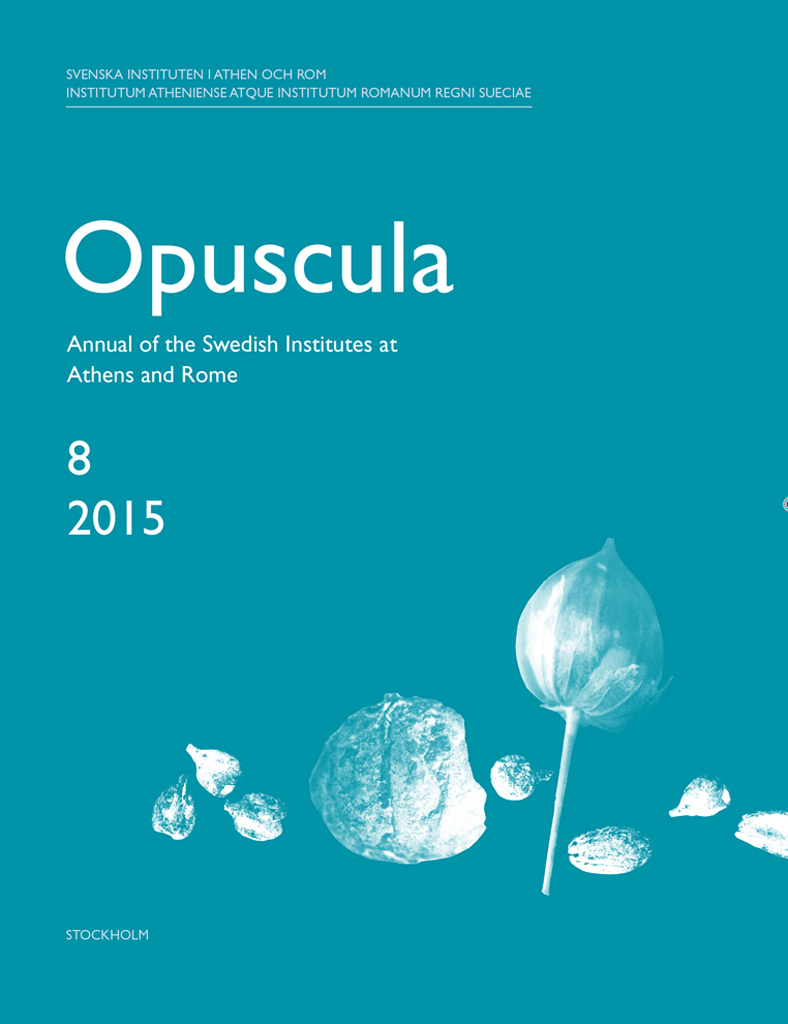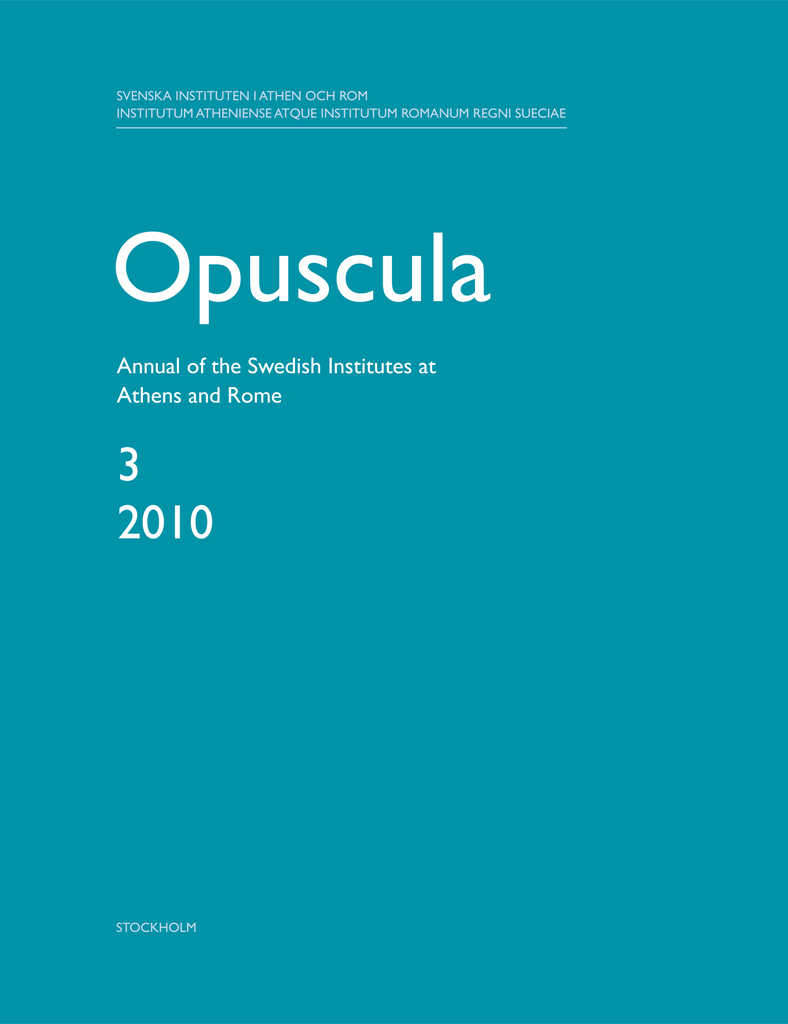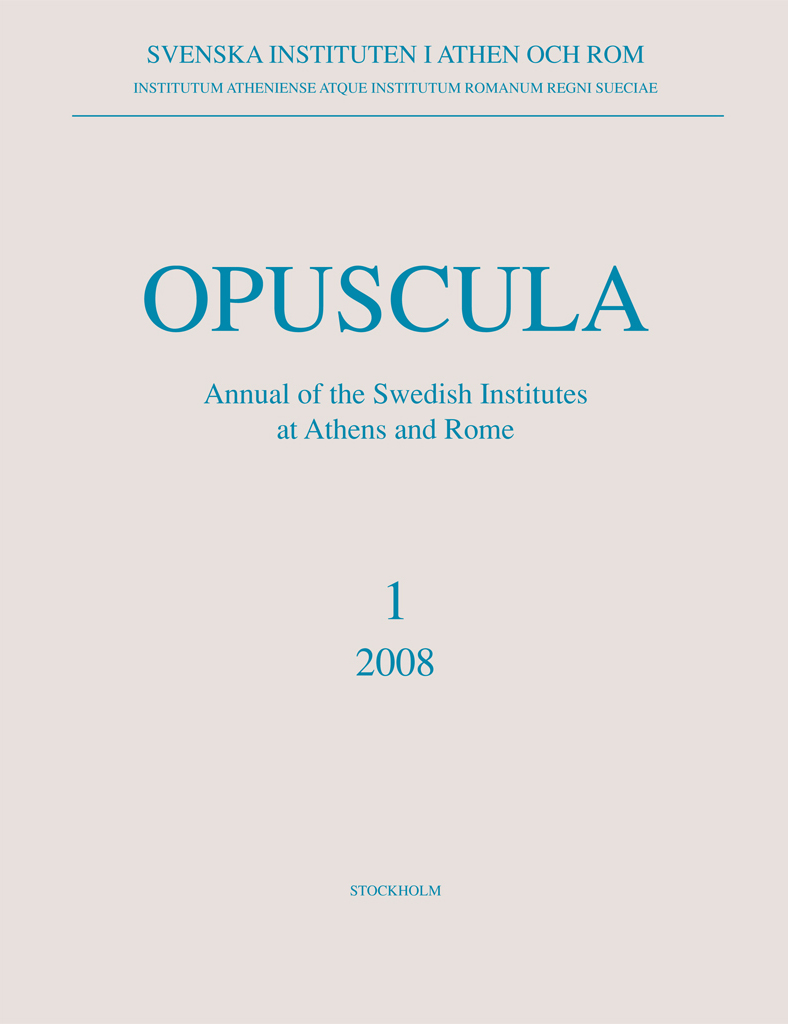Opuscula is published by the Swedish Institutes at Athens and Rome, with the aid of a grant from the Swedish Research Council. Distributed by Eddy.se AB. View journal at ERIH PLUS. All content available with open access. The Charitonidis Class: A group of large Athenian Late Protogeometric skyphoi By John K. Papadopoulos Abstract This article assembles and publishes a group of distinctive large Athenian Late Protogeometric skyphoi. Aspects of shape and decoration are fully discussed, so too the evidence for establishing the date of the group, as well as their distribution. The group, if not the potter, is named after the man who published two complete examples of the class from the South Slope of the Athenian Acropolis: Serapheim Charitonidis. Bibliographical information John K. Papadopoulos, ‘The Charitonidis Class: A group of large Athenian Late Protogeometric skyphoi’, Opuscula. Annual of the Swedish Institutes at Athens and Rome (OpAthRom) 8, Stockholm 2015, 7–26. ISSN: 2000-0898. ISBN: 978-91-977798-7-6. https://doi.org/10.30549/opathrom-08-02
Opuscula is published by the Swedish Institutes at Athens and Rome, with the aid of a grant from the Swedish Research Council. Distributed by Eddy.se AB. View journal at ERIH PLUS. Content available with open access. The bronze headbands of prehistoric Lofkënd and their Aegean and Balkan connections By John K. Papadopoulos Abstract This paper begins with an overview of the bronze headbands from the prehistoric (Late Bronze to Early Iron Age) burial tumulus of Lofkënd in Albania, which were found among the richest tombs of the cemetery, all of them of young females or children. It is argued that these individuals represent a class of the special dead, those who have not attained a critical rite de passage: marriage. In their funerary attire these individuals go to the grave as brides, married to death. The significance of the Lofkënd headbands is reviewed, as is their shape and decoration, but it is their context that contributes to a better understanding of Aegean examples, including the many bronze, gold, and silver headbands found in tombs from the Early Bronze Age through the Early Iron Age, as well as those dedicated as votive offerings in sanctuaries. In addition to discussing the evidence…
Opuscula is published by the Swedish Institutes at Athens and Rome, with the aid of a grant from the Swedish Research Council. Volume 1 is out of print. View journal at ERIH PLUS. Content available with open access. The Archaic wall of Athens: reality or myth? By John K. Papadopoulos Abstract This paper reviews the philological and archaeological evidence for an Archaic, pre-Persian, city wall of Athens, and concludes that there was no Archaic enceinte separate from the fortifications of the Acropolis and Pelargikon. The extant testimonia, primarily Thucydides and Herodotos, can be interpreted in different ways, but there is nothing in these sources to suggest categorically fortifications other than those of the Acropolis/Pelargikon. Previous arguments put forward for the existence of such a putative wall do not stand up to closer scrutiny and, despite extensive excavations in those areas where the wall has been claimed, there is to date no archaeological evidence for an Archaic wall. The wall that the Persians breached in their sack of Athens in 480/79 B.C. was the Mycenaean circuit wall surrounding the Acropolis and Pelargikon; together these walls, built in the Mycenaean period, continued to serve through the Archaic period until 479 B.C. when…
Opuscula is published by the Swedish Institutes at Athens and Rome, with the aid of a grant from the Swedish Research Council. Distributed by Eddy.se AB. View journal at ERIH PLUS. Content available with open access. Opuscula. Annual of the Swedish Institutes at Athens and Rome 1, 2008 Contents ‘Front matter‘, 1–6 Katie Demakopoulou, Nicoletta Divari-Valakou, Monica Nilsson, Ann-Louise Schallin, with an appendix by Kalliopi Nikita, ‘Excavations in Midea 2006’, 7–30 https://doi.org/10.30549/opathrom-01-02 John K. Papadopoulos, ‘The Archaic wall of Athens. Reality or myth?’, 31–46 https://doi.org/10.30549/opathrom-01-03 Anton Bonnier, ‘Epineia kai limenes. The relationship between harbours and cities in ancient Greek texts’, 47–61 https://doi.org/10.30549/opathrom-01-04 Fabrizio Vistoli, ‘Una nuova acquisizione di ceramica “white-on red” dall’ager Veientanus’, 63–77 https://doi.org/10.30549/opathrom-01-05 Ola Wikander, ‘The religio-social message of the gold tablets of Pyrgi’, 79–84 https://doi.org/10.30549/opathrom-01-06 This contribution is only available in print. Milette Gaifmann, ‘Visualized rituals and dedicatory inscriptions on votive offerings to the Nymphs’, 85–103 https://doi.org/10.30549/opathrom-01-07 Gabriella Barbieri, ‘Materiali inediti da Sovana. Alcuni corredi funerari dalla necropoli di San Sebastiano’, 105–122 https://doi.org/10.30549/opathrom-01-08 This contribution is only available in print. Maria Gabriella Scapaticci, ‘Nuovi dati sul popolamento nella pianura di Tarquinia durante la romanizzazione. Il caso della località “Il Giglio”‘, 123–135 https://doi.org/10.30549/opathrom-01-09 Paavo Roos, ‘A forgotten tomb…




